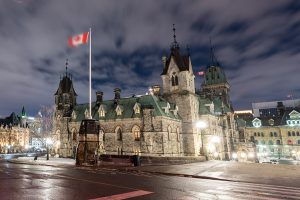The shows must go on
George Lee,
Local Journalism Initiative Reporter
Alberta’s magnificent countryside and historic downtowns will continue unfolding across screens here and abroad, incentives supported in Budget 2024 suggest.
A $5.4-million pot for project grants is not merely so the people of Fort Macleod and Grande Prairie can blurt “I’ve been there!” through their popcorn. The numbers show that the business case for film and TV is as strong as the wind across the Prairies, the government says.
Every dollar of support generates four dollars in provincial investment, which justifies putting money into “securing Alberta’s position as a filmmaking production hub through targeted incentives,” says the UCP budget tabled Feb. 29 by Finance Minister Nate Horner.
Alberta has been a hotspot for the making of movies and TV shows for decades, despite a slump in the late 1990s because of a major funding elimination. Often, Alberta’s countryside, cities, towns and tourist destinations stand in for U.S. locales, and Albertans are now well accustomed to seeing their neighbourhoods and scenic vistas splashed before their eyes.
Since 2020, the Alberta government has helped fund 267 screen-based projects, the responsible ministry says. These have resulted in a $1.2-billion spend-back in the province and created over 4,000 jobs.
Tanya Fir, the minister of arts and culture and the member for Calgary-Peigan, said in an email statement that the government is “very proud of these numbers, and we will continue to find new ways to expand this booming sector. We are seeing numerous award-winning productions choose Alberta because of our trained and ready workforce, breathtaking filming locations and low corporate tax rates.”
Alberta’s general corporate income tax rate is eight per cent, the lowest of all Canadian provinces. In 2022 the province said 3,200 new workers a year are launched into the creative industries by post-secondary institutions. The category includes much of the technical and artistic workforce behind making movies and TV shows.
In all, the province is earmarking $8 million for the Alberta Media Fund, maintaining last year’s record dollar figure for screen and cultural grants.
The Alberta Made Screen Industries Program accepts grant applications for production; post production, visual effects and digital animation; and project/script development.
Other grants in the media fund support organizations involved in music production and book and magazine publishing, along with some film, TV and video work.
Depending on criteria met, tax credits valued at 22 or 30 per cent of production and labour costs come via the provincial Film and Television Tax Credit. New rules will open that eligibility window wider, to 120 days from the start of a project, while also making reality and game shows eligible.
Alberta’s nearest Prairies neighbour earmarked $12 million in grants for film and TV last year, up $2 million from the previous budget. That number does not include a late-year top-up in Saskatchewan of $7.5 million in funding to meet unexpected demand.
Saskatchewan tax credits for the industry were eliminated in 2012. The general corporate tax rate there, at 12 per cent, is four percentage points higher than Alberta’s.
The Alberta formula appears to be working, a scan of recent productions suggests.
TV series like Billy the Kid, Fargo, and My Life with the Walter Boys make the success-story list, along with Disney’s feature-length film Prey.
Fort Macleod is transformed, from some angles at least, into the Austin, Texas, an entertainment and arts mecca promoted with the slogan Keep Austin Weird.
So does the post-apocalyptic TV drama The Last of Us, starring Pedro Pascal of The Mandalorian fame. It hopped all over the Alberta map, with scenes reportedly shot in or around Fort Macleod, High River, Bragg Creek, Okotoks, Waterton Lakes National Park, Olds, Stoney Nakoda First Nation, Priddis, Canmore, Calgary, Edmonton, Grande Prairie and other communities.
The British-Canadian TV production Tin Star, with Tim Roth playing a relocated London detective, filmed its first two seasons in Alberta locations like High River, Dorothy and Waterton.
Success stories started long before the current support structure.
Director Christopher Nolan, left, chats with an example the movie Interstellar’s star power, Matthew McConnaughey.
Released a decade go, Interstellar, a dystopian spacetime-warper starring Anne Hathaway and Matthew McConaughey, included location shoots in Fort Macleod, Nanton, Longview, Lethbridge and Okotoks.
Paul Gross’s Canadian First World War film Passchendaele, released in 2008, sent actors and crews to Fort Macleod, Calgary and Tsuut’ina Nation. Way back in the early 1990s, Clint Eastwood used Alberta’s Longview area to stand in for Wyoming in his seminal, Oscar-winning western The Unforgiven.
The year before the declaration of the COVID-19 pandemic, filming of Ghostbusters: Afterlife took place in Fort Macleod, Beiseker, Drumheller, Crossfield and other Alberta places.
Heartland, a long-running, family-friendly CBC Television series, is largely filmed in and around High River.
But does government money in film and TV have an impact on the industry?
Probably. Back in 1996, the Ralph Klein austerity movement saw the elimination of the Alberta Motion Picture Development Corporation. Reportedly, the value of film production dropped by about two thirds and the industry tanked.
Jake and The Kid was a short-lived TV series adapted from a collection of stories by iconic Canadian author W.O. Mitchell, filmed in the mid-1990s in and around Leduc. Production ended after the film corporation’s demise.
Too late for Jake and the Kid, provincial incentives – albeit at a reduced level – returned in 2001.
More Budget Numbers
Other creative work also receives support in Budget 2024. The Alberta Foundation for the Arts is set to receive a $4.5 million boost to $33.1 million this year, followed by $4.5 million for each of the next two years as well.
“This funding is specifically dedicated to supporting Alberta’s artists in all corners of our province,” the ministry’s statement says.
The budget earmarks $6.2 million for Alberta’s two Jubilee auditoriums and $1.8 million for other cultural industries.
For information about the film and TV production and grants, visit www.alberta.ca/alberta-made-screen-industries-program.
Information on claiming the tax credit can be found at www.alberta.ca/film-television-tax-credit.
George Lee,
Local Journalism Initiative Reporter
The Macleod Gazette




